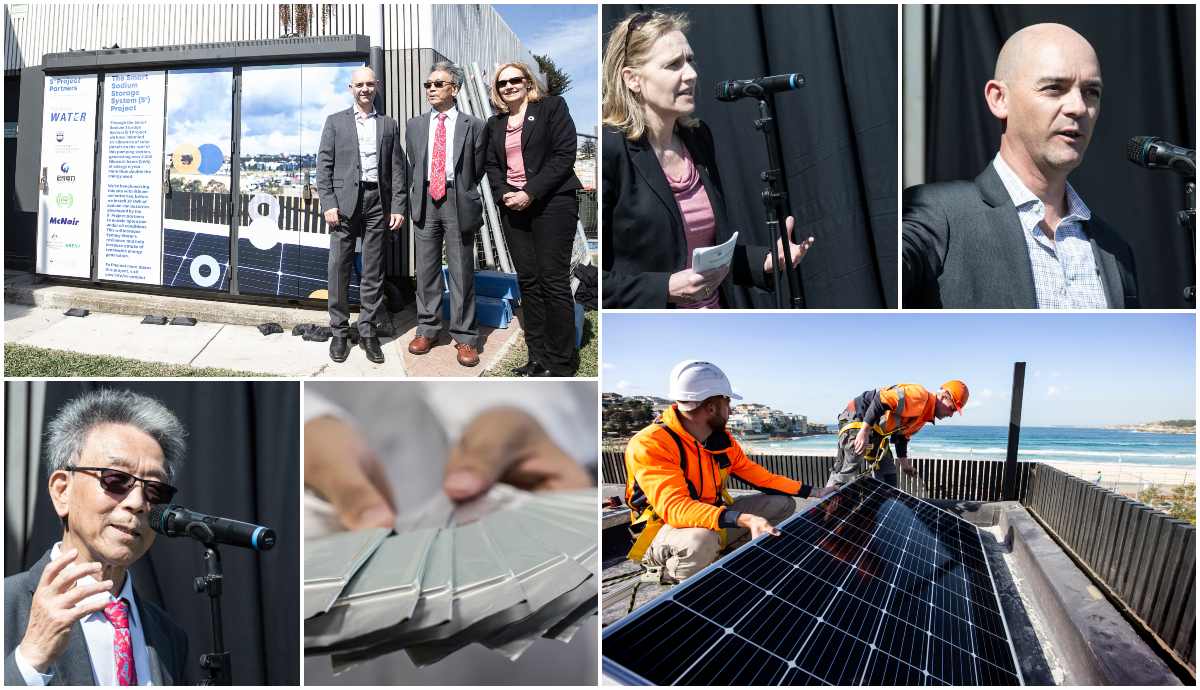October 27, 2018
Sun, sand and salt: Bondi gets ready for sodium-ion power play
Pumping station to capture and store more energy than it uses
Commissioning has been completed on a renewable energy generation system, which includes 6 kilowatts (kW) of solar panels, a temporary lithium-ion battery pack and an energy management system to maximise energy efficiency.
The installation is part of the $10.6 million Smart Sodium Storage System Project, funded largely by the Australian Renewable Energy Agency (ARENA), to develop and demonstrate sodium-ion batteries in renewable energy storage applications.
The project is led by energy storage researchers from the University of Wollongong’s (UOW) Institute for Superconducting and Electronic Materials (ISEM) in collaboration with Sydney Water and manufacturing partners in China.
It creates a commercialisation pathway, taking the technology from the lab to industry to fast-track the development of low-cost storage for renewable energy.
The Bondi pumping station is one of 780 in the Sydney Water network and is showing how sodium-ion batteries can be used to store renewable energy and increase system resilience through self-generation, storage and consumption of energy on site.
 The Sydney Water Bondi pumping station is a demonstration site for capturing, storing and using renewable energy against highly intermittent and impulse-heavy loads.
The Sydney Water Bondi pumping station is a demonstration site for capturing, storing and using renewable energy against highly intermittent and impulse-heavy loads.
It was chosen as a demonstration site due to the daily volume of wastewater it moves as well as proving the technology against highly intermittent and impulse-heavy loads.
The system will generate approximately 8,000 kilowatt-hours of energy each year – significantly more than is required to run the site.
ARENA CEO Darren Miller said: “Part of ARENA’s role is to deliver secure and reliable electricity and battery technology will play a major role in allowing variable renewable energy to be dispatchable.
“Thanks to the contribution of world-leading researchers from the University of Wollongong, these relatively inexpensive and reliable sodium-ion batteries aren’t too far off, potentially reducing our reliance on lithium.
“We’re always excited to support significant R&D which shows promising commercialisation prospects as the novel sodium-ion technology will assist in the faster uptake of renewable and innovative storage solutions for Australia,” Mr Miller said.
ISEM Director Professor Shi Xue Dou said the project was translating research outcomes into tangible impacts for society.
“Reducing our dependence on fossil fuels cannot be realised without an efficient storage system,” he said.
“Sodium-ion batteries are a potential game-changer because the materials are much more abundant than those for traditional lithium-ion batteries, reducing the cost of the raw materials as well as reducing reliance on scarce and expensive lithium.
“Critically, this project will deliver commercial-scale and ready-for-manufacture sodium-ion battery technology that allows lower-cost distributed renewable energy supply to become a reality.”
Sydney Water project engineer Peter Anders said that while most people press the flush button and don’t give the process a second thought, moving wastewater around our 25,000 kilometres of wastewater pipes so that it can be treated, protecting health and the environment, is an energy-intensive process.
“Sydney Water is always looking to increase the resilience in our networks and to minimise our energy consumption.”
Dr Heri Bustamante, principal scientist, treatment, at Sydney Water said: “By using the new technology of sodium-ion batteries, Sydney Water will be able to achieve increases in our renewable energy use, which will improve environmental outcomes and provide downward pressure on costs for our customers.”
Lithium-ion batteries will be used for one year to test the energy management system and will later be replaced with the sodium-ion batteries in late-2019.
Development of the sodium-ion battery packs is now in a critical phase, with the first batches of batteries rolling off production lines at industry partner sites in China.
The commissioning of the renewable energy generation system at the Bondi sewage pumping station coincides with the launch of a new S4 Project website, which contains key information about the project and deliverables – s4.isem.uow.edu.au.
Partners in the S4 Project include: ARENA, the University of Wollongong, Liao Ning Hong Cheng Electric Power Co., Hebei ANZ New Energy Technology Co., McNair Technology Co., and Sydney Water.
:format(jpg)/prod01/channel_3/assets/live-migration/www/images/content/groups/public/web/media/documents/mm/uow252937.jpg)